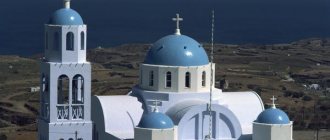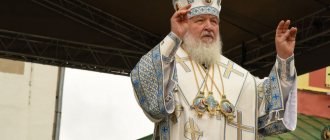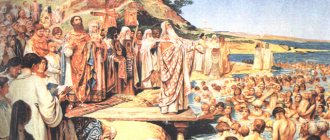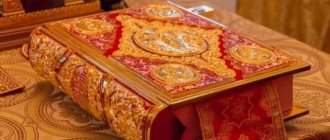In Ukraine, disputes regarding the Orthodox Church do not subside. Now there are three of them:
- Ukrainian Orthodox Church of the Moscow Patriarchate (UOC MP);
- Ukrainian Orthodox Church of the Kyiv Patriarchate (UOC KP);
- Ukrainian Autocephalous Orthodox Church.
The world Orthodox community accepted only the first, which in 1686 passed from the department of Constantinople to Moscow. The autocephaly of the Ukrainian Orthodox Church appeared at the beginning of the twentieth century, but since then it has not been recognized by the canonical church; it is not subordinate to anyone.
Years of the Civil War 1917-1922
The first attempts to create an autocephalous church were made in Ukraine during the collapse of Russian statehood after the February and October revolutions of 1917. With the support of the self-proclaimed Ukrainian Central Rada, in the summer of 1917, a group of Orthodox priests and laity took the initiative to hold an All-Ukrainian Church Council, create an autocephalous church and Ukrainianize worship. The leader of the movement was Archpriest Vasily Lipkovsky, who was soon deprived of his priesthood for schismatic activities.
The activities of supporters of autocephaly met with resistance from most of the clergy and believers of Ukraine. On the initiative of Archbishop Evlogiy (Georgievsky) of Volyn, an All-Ukrainian Church Council was held in Kyiv in January 1918, the majority of the delegates of which opposed the establishment of an autocephalous Orthodox Church in Ukraine.
On January 1, 1919, the directory of the Ukrainian People's Republic adopted the law “On the autocephaly of the Ukrainian Orthodox Church and its supreme government.” Through their ambassador to Turkey, the Ukrainian authorities tried to achieve recognition of the self-proclaimed church by the Patriarchate of Constantinople, but were unsuccessful.
Later, with the support of the Bolsheviks, the first Ukrainian parishes of Lipkovsky’s supporters were registered in the Ukrainian SSR. The Russian Orthodox Church (since 1943 - the Russian Orthodox Church, ROC), led by Patriarch Tikhon (Belavin), considered the actions of the autocephalists in Ukraine as a schism.
On May 5, 1920, activists of the Ukrainian nationalist movement proclaimed the “Ukrainian Autocephalous Orthodox Church” (UAOC). None of the Orthodox bishops took part in making this decision. On October 14, 1921, supporters of the UAOC convened the so-called. All-Ukrainian Orthodox Church Council, the participants of which were only 64 priests and 17 deacons. The Patriarchal Exarch of Ukraine, Metropolitan Mikhail (Ermakov), refused to attend this meeting. Rejecting the candidates proposed by Ukrainian nationalists, he declared that he would not ordain “vipers as bishops.” As a result, the Ukrainian “bishops” were elevated to the rank in violation of canonical rules, in particular Vasily Lipkovsky himself “dedicated” himself to the highest church rank (according to church canons, only two other bishops can do this). The UAOC was not recognized by any of the canonical Orthodox churches.
Literature[ | ]
- Maltsev V. A.
Kiev Patriarchate-2: reboot // NG-Religions. — 06/17/2015. - MEFODIY (Kudryakov). Metropolitan of Kiev and all Ukraine, Primate of the Ukrainian Autocephalous Orthodox Church. One people. One language. One Church: The collection takes place until the 15th anniversary of the Presidency. — K.: Vidavnichy contribution to the Metropolitan Methodius Memory Fund, 2015. — 311
- Petrushko V.I.
Autocephalist schisms in Ukraine in the post-Soviet period, 1989-1997. - M.: Orthodox St. Tikhon's Theological Institute, 1998. - 254 p. — ISBN 5-7429-0065-1 - Yarema Rostislav, priest.
Church schisms in Ukraine: dedicated to the fifteenth anniversary of the Kharkov Council of Bishops of the Ukrainian Orthodox Church. — Kyiv: Ukrainian Orthodox Church. Kyiv Metropolis, 2007. - 95 p. - Bochkov P.V., priest.
History and current state of the non-canonical jurisdiction of the “Ukrainian Autocephalous Orthodox Church” (since 1989) // Ryazan Theological Bulletin. - 2015. - No. 2. - P. 55-81. - Zaporozhets V. A.
Peculiarities of the internal church life of the UAOC for Patriarch Dimitri (Yaremi) // Scientific book of hours of the National Pedagogical University named after M. P. Drahomanov. Episode 7: Religion. Culturology. Philosophy: zb. Sci. fuck off. — Kiev: Type of NPU named after M. P. Drahomanov, 2021. — Vip. 38 (51). — P. 3-9. - Zaporozhets V.
Specifics of the functioning of the UAOC in the 90s. XX century: religious studies formulation of the question // Modern Science - Moderní věda. 2021. - Volume: 5. No. 1. - P. 54-60 - Shumilo S.V.
Formation of the hierarchy of the UAOC in 1990 and the self-proclaimed “bishop” Vikenty Chekalin // Church and Time. — 2021. — No. 3. — P. 154—212
UAOC during the Soviet period
Until the mid-1920s, the Soviet authorities supported the development of the UAOC, hoping in this way to weaken the Russian Orthodox Church, led by Patriarch Tikhon. However, since 1929, Soviet intelligence services began mass arrests of autocephalists. In 1930, the UAOC announced its self-dissolution. In 1942, on the territory of Ukraine, which was under German occupation, the activities of the UAOC were restored. However, after the retreat of German troops, representatives of the UAOC emigrated and founded their dioceses in places where the Ukrainian diaspora was densely populated, primarily in the USA and Canada.
In 1989, the restoration of the activities of the UAOC in Ukraine was again officially proclaimed in Lvov. In 1990, the so-called a local council of a religious organization, its charter was adopted, and Symon Petliura’s nephew “Metropolitan” Mstislav Skrypnyk, who returned from emigration to the United States, was proclaimed “Patriarch of Kyiv and all Ukraine.” Currently, the UAOC is headed by “Metropolitan” Macarius Maletich.
Attempts to create an autocephalous church in Ukraine in the 1990-2000s
Since 1991, the Ukrainian authorities have repeatedly made attempts to create their own autocephalous Orthodox Church. In 1991, this process, with the support of Ukrainian President Leonid Kravchuk, was initiated by Metropolitan of Kiev Filaret (Denisenko), who at that time was the head of the self-governing Ukrainian Orthodox Church (UOC) of the Moscow Patriarchate. In early November 1991, the cathedral of the UOC in Kyiv sent an appeal to the Moscow Patriarchate with a request to grant the Ukrainian church autocephaly. However, later the majority of Ukrainian bishops withdrew their signatures from the document, explaining their actions with threats and pressure from Filaret. The most active opponents of autocephaly, in particular Bishop of Chernivtsi and Bukovina Onuphry (Berezovsky; now the head of the UOC), were removed by Filaret from their sees.
In 1992, the Council of the UOC removed Filaret from the post of head of the church and banned him from serving. Then he was deprived of his dignity and “all degrees of the priesthood” by the Council of Bishops of the Russian Orthodox Church. Denisenko himself did not recognize these decisions and, with the support of Leonid Kravchuk, announced the creation, together with the UAOC, of a non-canonical religious organization - the “Ukrainian Orthodox Church of the Kyiv Patriarchate.”
In 1992, during a trip to Istanbul (Turkey), former Metropolitan Filaret unsuccessfully tried to negotiate recognition of his jurisdiction by the Orthodox Church of Constantinople. However, in July 1993, Patriarch Bartholomew I of Constantinople (Archondonis) officially stated that he recognizes only the canonical head of the UOC, Metropolitan Vladimir (Sabodan) of Kyiv. In 2008, under Ukrainian President Viktor Yushchenko, an attempt was made to negotiate with Constantinople on recognizing the jurisdiction of the UOC headed by Filaret, but to no avail.
Sources [edit]
- Ukrainian Autocephalous Orthodox Church in America
| vteAll-Ukrainian Council of Churches and Religious Organizations | |
| Members |
|
| Odessa Association of Christian Churches | |
| Authoritative control |
|
Creation of the Ukrainian autocephalous church in 2021
After the coup in Ukraine in February 2014, the new authorities began to actively put forward the idea of creating a local Orthodox church in the country, which would not be associated with the canonical Ukrainian Orthodox Church of the Moscow Patriarchate. On June 16, 2016, the Verkhovna Rada sent a corresponding appeal to Patriarch Bartholomew I.
In April 2021, Ukrainian President Petro Poroshenko wrote a personal letter to Bartholomew asking him to grant autocephaly to a “united” Orthodox jurisdiction. He also noted that representatives of the non-canonical Kyiv Patriarchate and the UAOC joined his appeal. On April 19, 268 deputies of the Verkhovna Rada voted for the bill in support of Poroshenko’s appeal (36 were against). On April 21, the head of the UOC, Metropolitan of Kiev and All Ukraine Onufriy (Berezovsky), assessed the actions of the president and deputies as “abuse of power” and “interference in church affairs” (the church, in accordance with Article 35 of the Constitution of Ukraine, is separated from the state).
On July 1, Bartholomew I stated that the Patriarchate of Constantinople considers Ukraine as its canonical territory and “considers it necessary to strive to restore church unity.” On September 7, “in preparation for the granting of autocephaly to the Orthodox Church in Ukraine,” he appointed his exarchs (leaders of the ecclesiastical region) in Kyiv. They were Archbishop Daniel (Zelinsky) of Pamphylia from the Ukrainian Orthodox Church in the USA and Bishop Hilarion (Rudnik) of Edmonton, belonging to the Ukrainian Orthodox Church of Canada (both of these self-governing jurisdictions operate among the Ukrainian diaspora in North America and are subordinate to the Patriarch of Constantinople).
The Holy Synod of the Russian Orthodox Church regarded the actions of Constantinople as “a gross violation of church canons,” which prohibit the bishops of one local church from interfering in the affairs of another. The Chairman of the Synodal Department for Relations between the Church and Society and the Media, Vladimir Legoyda, explained that autocephaly “can only be granted to a canonical church structure,” and in Ukraine this is the UOC within the Moscow Patriarchate. In addition, he noted that the administration of the Kyiv Metropolis (i.e., the ecclesiastical region that includes most of modern Ukraine) was finally transferred by Constantinople to the Russian Church in 1686.
On September 14, the Holy Synod of the Russian Orthodox Church appealed to the heads of local Orthodox churches to convene a pan-Orthodox council to discuss the situation in Ukraine and suspended the commemoration of Patriarch Bartholomew during divine services.
On the same day, press secretary of the “Kyiv Patriarchate” Evstratiy Zorya said that supporters of the creation of an autocephalous Ukrainian church are planning to hold a council in Kiev, in which representatives of the “Kiev Patriarchate”, the UAOC, as well as a number of bishops of the canonical UOC - supporters of autocephaly are expected to participate. The council is scheduled to elect a “primate” who should receive a tomos (decree) on autocephaly from the hands of Patriarch Bartholomew I.
On October 11, the Synod of the Church of Constantinople announced the cancellation of the 1686 decision on the transfer of the Kyiv Metropolis to the jurisdiction of the Russian Church, and also announced the lifting of the previously imposed anathema on the leaders of the “Kiev Patriarchate” and the UAOC Filaret Denisenko and Makariy Maletich. The Ukrainian Orthodox Church and the Russian Orthodox Church called these decisions illegal.
Temples and influence
Among the losses that the Moscow Patriarchate can expect are, first of all, churches. The Moscow Patriarchate in Ukraine has about 11 thousand of them. Moreover, the difficulty is that churches in the country are considered to belong to parishioners, that is, they will have to decide at a vote whether to come under the wing of the Kyiv Patriarchate or not. As a result, this could lead to serious conflicts among local believers and thereby further strain relations between countries. Archpriest Alexander Ilyashenko believes that everything that is happening is the result of behind-the-scenes games of those in power, while the prospects for creating a single local church in Ukraine are far from joyful. “This is a political question, because the Ukrainian church already has almost all the attributes of an autocephalous church. This concerns the Orthodox Church of the Moscow Patriarchate. The Church has great autonomy, and for believers there is no difference. The question is that today Petro Poroshenko wants to give autocephaly to another church, non-canonical and not recognized by anyone. It is clear that this is being done in order to split the Ukrainian people also along religious lines, to sow discord and contradictions between people. Obviously, this will lead to clashes, which will be caused by the fact that the newly-founded autocephalous church will be given churches and monasteries belonging to the UOC-MP. When there are political forces behind such a church, it is clear who will be given preference and in whose direction the advantage will be. This will be a tragedy that could happen before our eyes,” says Father Alexander.
Article on the topic
Nationalist crusade. Expert - about the inter-church conflict in Ukraine
In his opinion, all attempts to change the status of the church in Ukraine will only deepen the split in Orthodoxy. Moreover, according to Father Alexander, political forces are clearly behind the decisions of the Council of Bishops. “It's quite obvious. After all, whenever any crime occurs, people ask the question: who benefited from it? And it is beneficial for those who want to achieve the isolation of Russia and the Russian people, including by breaking the unity of Orthodoxy in our space. This could end in a split on an international scale as well. This is a well-thought-out and multi-step operation that will bring those who want to destroy everything big dividends, which they are going to receive by sowing this confrontation,” says Father Alexander.
Severance of relations between the Russian Orthodox Church and Constantinople
On October 15, 2021, the Synod of the Russian Orthodox Church decided to sever Eucharistic communion with the Patriarchate of Constantinople. According to the statement of the Russian Orthodox Church, “an encroachment on other people’s canonical inheritances, an attempt to renounce one’s own historical decisions and obligations, takes the Patriarchate of Constantinople beyond the canonical field.” From October 15, it is impossible for all clergy of the Russian Orthodox Church to jointly participate in divine services with clergy of the Church of Constantinople, and for laity to participate in the sacraments performed in its churches.
The Synod statement said that Constantinople, in its actions, refers to the non-existent “canonical privileges of the Patriarch of Constantinople to accept appeals from bishops from all autocephalous Churches.” The assignment by Constantinople of the authority to cancel the decisions of other local Orthodox churches is considered by the Russian Orthodox Church as a manifestation of a false teaching (heresy), ascribing to the patriarch the rights of “first without equal (primus sine paribus) with universal jurisdiction.”
An attempt by Constantinople to repeal the act of 1686 on the transfer of the Kyiv Metropolis to the jurisdiction of the Russian Church was declared illegal by the Russian Orthodox Church. The Synodal Charter of 1686 and other documents accompanying it say nothing about their temporary nature or that this act can be canceled. In addition, the Synod of the Russian Orthodox Church indicated that the canonical territory of the Kyiv Metropolis of 1686 is significantly smaller than the canonical territory of the modern Ukrainian Orthodox Church, most of whose dioceses were founded and developed within the Russian Church.
On November 11, the Council of Bishops of the UOC stated that the decisions of the Patriarchate of Constantinople of October 11, 2021 are invalid and have “no canonical force.”
Autonomy and self-government - what's the difference?
There are autonomies within the autocephalous church.
They can choose their leader in consultation with the mother church, and generally have freedom in deciding a wide range of internal issues. Autonomy comes in different degrees. In the Russian Orthodox Church, the autonomies include the Japanese and Chinese Autonomous Churches.
And there are self-governing churches. They are often more limited in independence than autonomy, but can also choose their own leader. However, the degree of independence from the mother church among them, as well as among the autonomies, varies greatly.
For example, the Ukrainian Orthodox Church (Moscow Patriarchate) is listed in the Charter as “self-governing with the rights of broad autonomy.” In practice, it has such broad rights that it is more like an independent autocephaly than an autonomy, but it is not included in the synodic of autocephalous churches.
Also self-governing churches are the Orthodox churches of Estonia, Latvia and Moldova, but their independence is much less.
Reaction of other churches
The heads of a number of churches spoke out against the unilateral decision of Constantinople to create an independent church in Ukraine. In particular, Serbian Patriarch Irinej (Gavrilovich) stated that new autocephalies should be created only with the consent of all local Orthodox churches. A similar position was taken by the synods of the Antiochian and Polish Orthodox Churches and the Orthodox Church in America. Patriarch Theodore II of Alexandria spoke out in support of the canonical UOC.
On November 12, 2021, the Synod of the Serbian Orthodox Church called “canonically unfounded” the decision of Constantinople to rehabilitate the leaders of the Ukrainian schism Filaret Denisenko and Mikhail Maletich. The hierarchs of the Serbian Church proposed to the Patriarchate of Constantinople and all other local Orthodox churches to consider the “Ukrainian question” at a pan-Orthodox council in order “in the future to avoid the temptation through which holy Orthodoxy is now passing.”
Who decides on autocephaly and how?
Autocephalous churches are independent only relative to other autocephalous churches. They are part of the Universal Church and are subordinate to it. The highest church authority decides to grant autocephaly to a particular church.
Under these conditions, the highest authority of the mother church makes an appropriate decision and endows autocephaly with rights, powers and freedoms, the main of which is territorial independence, independence in decision-making and issuing decrees and disposal of property.
Creation of the “Orthodox Church of Ukraine”
On December 15, 2021, in Kyiv, under the leadership of representatives of the Patriarch of Constantinople and with the direct participation of the President of Ukraine Petro Poroshenko, the so-called. a unifying council of two non-canonical religious organizations: the “Kyiv Patriarchate” and the “Ukrainian Autocephalous Orthodox Church” (190 people in total, the majority are members of the “Kyiv Patriarchate”). Of the 97 bishops of the canonical UOC, only two joined the schismatics - Metropolitans Simeon (Shostatsky) and Alexander (Drabinko). Later they were defrocked and removed from the administration of dioceses by decision of the Synod of the UOC. Following the event, Petro Poroshenko announced the creation of a new church structure in the country - the “Orthodox Church of Ukraine” (OCU). It received the status of an “autocephalous church” within the Patriarchate of Constantinople. It was headed by “Metropolitan of Kiev and All Ukraine” Epiphany Dumenko. Filaret Denisenko, Makariy Maletich and former Metropolitan of Vinnitsa and Bar Simeon (Shostatsky) were declared permanent members of the “synod” of the OCU. The “Kiev Patriarchate” and the UAOC announced their self-dissolution.
Notes[ | ]
- Khulap V.F.
Reform of the calendar and Easter: history and modernity. - ↑ 12
The Kiev Patriarchate and the UAOC dissolved themselves before the Council // RBC-Ukraine, 12/15/2018 - The UAOC ceased to exist // Interfax, 08/14/2019
- ↑ 1 2 3 4 5 6
History of the UAOC.
Part 8. The newest revival of the UAOC (undefined)
. Ukrainian Autocephalous Orthodox Church (November 17, 2015). Access date: November 20, 2015. - Hierarchy of churches | Russian Orthodox Catholic Church (undefined)
. www.hierarchy.religare.ru. Access date: July 14, 2021. - Vikenty Chekalin (undefined)
. www.anti-raskol.ru. Access date: July 14, 2021. - VIII. False patriarchs Dimitry Yarema and Volodymyr Romanyuk and “schism within a schism” // Petrushko V.I.
Petrushko V.I.
Autocephalist schisms in Ukraine in the post-Soviet period, 1989-1997. - M.: Orthodox St. Tikhon's Theological Institute, 1998. - 254 p. — ISBN 5-7429-0065-1 - Patriarchate of the UAOC
- CONSISTORY OF KHARKIV-POLTAVYE PARCHY OF THE UKRAINIAN AUTOCEPHAL ORTHODOX CHURCH (UPDATED) - review of the publicity and business reputation of the counterparty - financial analysis ...
- The UAOC is in serious crisis. The Lviv-Sambirsk diocese transferred to Filaret - Express, 04.04.2013
- The Kiev Patriarchate received two bishops of the UAOC and criticized the ROC for “distorting the essence of the holy day” of the baptism of Kievan Rus - Religion in Ukraine, 05.14.2013
- The UAOC asks to the Patriarchate of Constantinople // Ukrainian Truth, 08.28.2009
- ↑ 1 2
Message of His Beatitude Metropolitan Methodius to the priesthood of the UAOC |
Memory Fund of Blessed Metropolitan Methodius of the UAOC (unspecified)
. mefodiy.org.ua. Date accessed: November 9, 2015. - The UAOC wants to join the Ecumenical Patriarchate with autonomy rights. RIA Novosti, 08/31/2009.
- Minin S.
Greek fire // NG Religions. — October 7, 2009. - Slesarev A.
Having re-ordained its “bishop”, the UAOC took another step towards rapprochement with the Patriarchate of Constantinople. Information and reference portal “Anti-Raskol”, 02/17/2011. - New Martyrs of Ukraine
- Resolutions of the bishops' councils of the UAOC (unspecified)
. (unavailable link) - Monastery of the Bishops' Council of the UAOC | St. Andrew's Church
- Khomenko S. An independent Orthodox Church has been created in Ukraine // BBC Russian Service, 12/15/2018
- Musafirova O. In Kyiv, at the Unification Council, the head of a church independent from the Russian Orthodox Church will be elected // Novaya Gazeta, 12/15/2018
- The media learned that the new Ukrainian Orthodox Church will not have a patriarch // Interfax, 12/15/2018
- Interfax-Religion: The UAOC ceased to exist (undefined)
.
www.interfax-religion.ru
(August 14, 2019).




